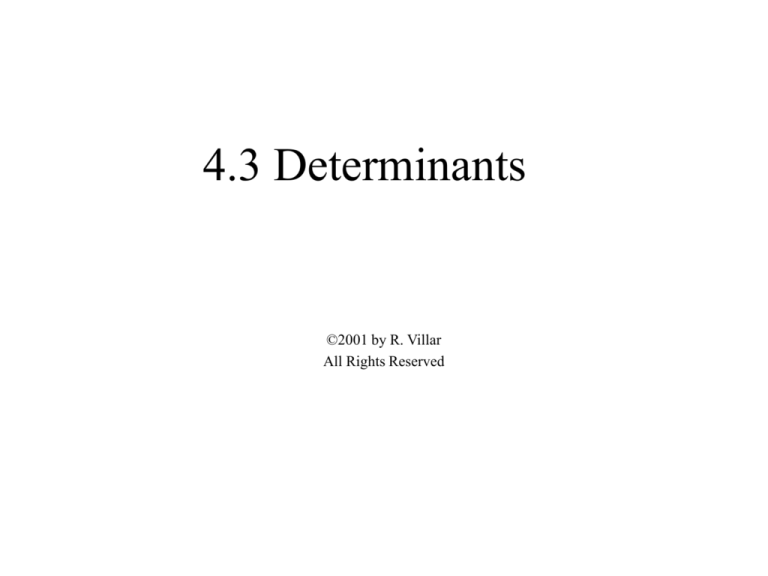
4.3 Determinants
©2001 by R. Villar
All Rights Reserved
Determinants
Square Matrix: A matrix with same number of rows
as columns.
3 5
2 1
2 by 2
0 2 1
3 1 4
2 5 0
3 by 3
Associated with a square matrix, is a determinant.
The determinant of a 2 X 2 matrix in the following
form...
a b
c d
… is ad – bc
Example. Find the determinant of the following matrix:
2 1
5
6
2•6–1•5
12 – 5
7
There are two methods to find the determinant of a 3 X 3 matrix...
One method is called the diagonals method:
a b c a b
d e f d e
g h i
g h
To use the diagonals method, first copy the first two columns...
Multiply and add diagonals as shown...
(aei + bfg + cdh) – (gec + hfa + idb)
… then multiply and add the other diagonals as shown...
… then subtract the two sums.
Example. Find the determinant of
2 1 1
3 1 2
4 1 5
2 1
3 1
4 –1
Copy the first two
columns...
…multiply and add diagonals in both directions...
…simplify and subtract...
(10 + 8 + –3) – (4 + –4 + 15)
15
–
15
0
The other method to find determinants of 3 X 3 matrices is
called Expansion by Minors.
Expansion by Minors uses 2 X 2 matrices within a 3 X 3, to
find the determinant...
Example. Evaluate the determinant by expanding the
minors along row 1:
We will start at the first entry in row 1.
Row 1 2 1 1
3 1 2
4 1 5
2
1 2
1 5
Use this as a scalar.
Now, multiply by the determinant of the
rows and columns not including the scalar
Example. Evaluate the determinant by expanding the
minors along row 1:
Now we will go to the second entry in row 1.
Row 1 2 1 1
3 1 2
4 1 5
2
1 2
1 5
–1
Use the opposite sign with this
entry as the scalar.
Multiply by the determinant of the rows
and columns not including the scalar
3 2
4 5
Example. Evaluate the determinant by expanding the
minors along row 1:
Finally, go to the third entry in row 1.
Row 1 2 1 1
3 1 2
4 1 5
2
1 2
1 5
–1
Use this entry (same sign) as
the scalar.
Multiply by the determinant of the rows
and columns not including the scalar
3 2
4 5
+1
3 1
4 1
Now, evaluate...
2(5 – –2) –1(15 – 8) + 1(–3 –4)
2(7) –1(7) + 1(–7)
0
Example. Evaluate the determinant by expanding the
minors along row 1:
You can expand by minors along any row but
2 1 1
3 1 2
4 1 5
the “sign pattern” will differ from row to row.
For Row 1, we saw that the sign pattern for
the scalars is
+ – +
For Row 2, the sign pattern for the scalars is
– + –
For Row 3, the sign pattern for the scalars is
+ – +
2
1 2
1 5
1 1
–3 1 5
4
1 1
1 2
–1
3 2
4 5
+1
2 1
4 5
– (–1)
2 1
3 2
+1
3 1
4 1
–5
2 1
4 1
+5
2 1
3 1
Determinants can be used to find the area of a triangle
whose vertices are points on a coordinate plane:
Area of a Triangle:
The area of a triangle with vertices
(x1 ,y1) , (x2 ,y2) , (x3 ,y3) is
(x1 ,y1)
(x2 ,y2)
x1 y1 1
1
Area x2 y2 1
2
x3 y 3 1
(x3 ,y3)
Where the + indicates the appropriate sign to get a positive value.
Example: Find the area of the triangle with vertices (1,7), (4,5),(2,2)
1
7 1
1
Area
4 5 1
2
2 2 1
Expansion by minors along row 1 gives:
+ 1/2 [1
5 1
2 1
+ 1/2 [ 1 (3)
–7
4 1
2 1
–7 (2)
+ 1/2 [ –13 ] = 13/2
+1
4 5
2 2
+ 1 (–2)
]
]









